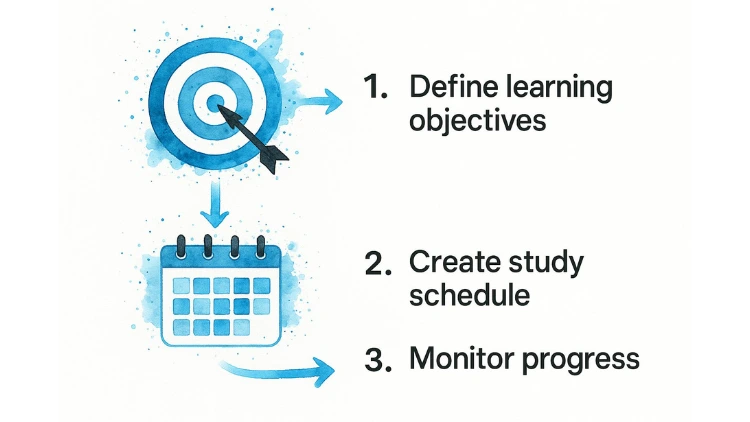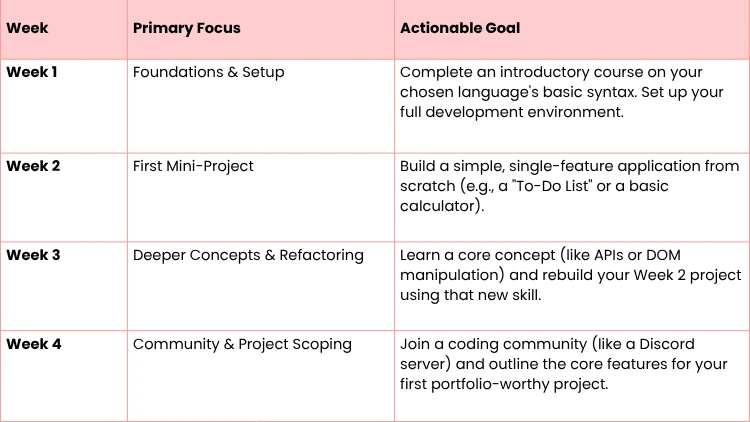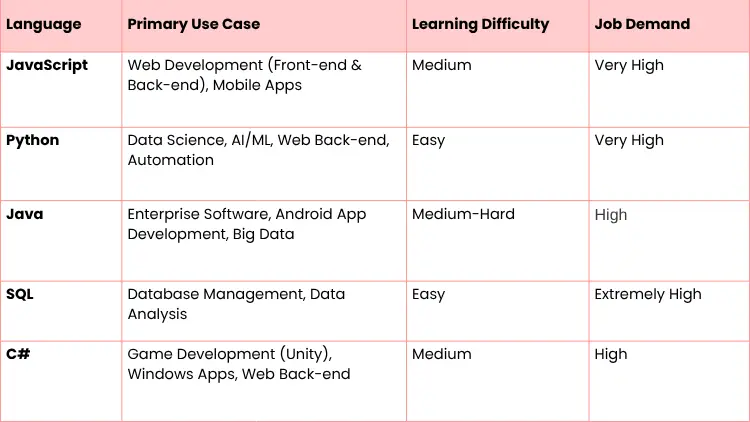How to Learn Coding Fast and Get Hired with Job-Ready Skills

Learning to code quickly isn't about magic tricks; it's about having a clear, strategic framework. The whole game boils down to setting a precise goal, like landing a front-end developer job, and then relentlessly mastering a single, high-demand language like JavaScript through hands-on projects from day one. This entire blueprint is built on one core idea: prioritize active building over passive learning.
Jump To Section

Earn As You Learn
Earn 25% commission when your network purchase Uplyrn courses or subscribe to our annual membership. It’s the best thing ever. Next to learning,
of course.
Your Blueprint for Rapid Skill Acquisition
The path to becoming a skilled coder doesn't have to take years of aimless wandering. What you need is a smart, structured approach that builds momentum fast. The goal is to shrink the gap between theory and real-world application, turning abstract concepts into the tangible skills that actually get you hired.
It all starts with defining a concrete, motivating goal. Forget a vague desire to "learn code". Instead, set a specific target like, "I will build and deploy a functional e-commerce website using React within four months". This kind of clarity is your North Star, keeping you focused and guiding every decision you make. As you map out this path, it's also smart to keep an eye on how the industry is evolving, especially with new insights on AI's impact on coding jobs and what that means for future developers.
Setting Your Strategic Foundation
Once you have a clear goal, your learning plan practically writes itself. This means picking one language and sticking with it until you're genuinely proficient. If you're aiming for a web developer role, that might mean dedicating 100% of your time to JavaScript and actively resisting the temptation to dabble in Python or C# on the side. This singular focus is crucial—it prevents cognitive burnout and dramatically speeds up the learning curve.
This focused, self-directed strategy is incredibly effective. In fact, research shows that approximately 77% of coding learners are self-taught, relying heavily on practical projects to build their expertise. Their success is fueled by powerful internal drivers, with 79% motivated by personal interest and 61% aiming for career advancement.
A successful learning journey isn’t about how much information you consume; it's about how many solutions you create. Every tutorial you watch should be immediately followed by you building something small on your own.
This simple, three-stage framework is visualized perfectly in the infographic below.
As the visual shows, a winning strategy moves logically from defining your "why" to creating a system for daily action and tracking your growth. This structured approach isn't just helpful; it's fundamental. If you're looking to really nail down this process, this guide on how to create an ongoing learning cycle can give you an even deeper dive into these concepts.

Your First 30 Days of Accelerated Learning
To make this even more concrete, here’s a look at how you can structure your first month for maximum impact.
This table breaks down a week-by-week plan to kickstart your coding journey and build unstoppable momentum right from the start.
Following a plan like this helps translate abstract goals into tangible weekly accomplishments, which is the key to staying motivated and making real, measurable progress.

Choosing Your Language and Learning Stack
If you want to learn to code fast, the first thing you need to do is stop thinking like a student and start thinking like a specialist. The goal isn't to learn everything—it's to learn the right things for a specific job.
Your first big decision is picking a programming language. This choice shouldn't be about what's "easiest" to learn. It should be laser-focused on the career path you want to follow. Before you even write a line of code, it’s helpful to understand the high-level differences between fields like web development vs mobile development. Getting this clarity upfront stops you from sinking months into a language that doesn't actually get you where you want to go.
Match Your Language to Your Goal
Your career target dictates your starting point. Simple as that.
Want to build beautiful, interactive websites? JavaScript is non-negotiable. Dreaming of a career in data science or AI? Python is the undisputed king. Aligning your language choice with a specific job is the single biggest shortcut you can take.
Here’s a quick look at the most common starting languages and where they can take you:
- JavaScript: The language of the web. It's essential for front-end work (using frameworks like React or Vue), but it also powers the back-end (Node.js) and even mobile apps (React Native). Its incredible versatility makes it a fantastic choice for getting hired quickly.
- Python: Famous for its clean, beginner-friendly syntax. Python is the go-to for data analysis, machine learning, and AI. It has a massive ecosystem of libraries that make complex tasks much simpler, making it a powerhouse for specialized roles.
- Java: A true workhorse. This robust language powers huge enterprise-level applications and a massive chunk of the Android app world. If you're aiming for a job at a large corporation or want to build native Android apps, Java is a rock-solid pick.
Build Your Personal Learning Stack
Once you've picked your language, you need to build a "learning stack". This isn't just one course or one book. It's a curated set of resources that reinforce each other to create a powerful learning environment.
A great learning stack moves you from passively watching tutorials to actively building and debugging code. That’s where the real learning happens. It combines structured lessons with unstructured, real-world problem-solving.
With so many amazing online platforms, building a custom stack has never been easier. And learner interests are definitely shifting; recent data shows 28% of learners plan to study AI next, with 33% already exploring AI or machine learning.
Here’s what a practical learning stack could look like for an aspiring front-end developer focusing on JavaScript:
- Core Instruction: Start with a comprehensive video course from an online learning platform to get the fundamentals of HTML, CSS, and JavaScript down.
- Interactive Practice: Use a site like freeCodeCamp or Codewars for daily coding challenges. This is crucial for drilling syntax and sharpening your problem-solving muscle.
- Official Documentation: Get into the habit of using the Mozilla Developer Network (MDN) as your go-to reference. It's what the pros use, and it's far better than just Googling for quick-fix answers.
- Community Support: Join a Discord or Slack community for your chosen language or framework. You'll get real-time help, see how others approach problems, and start building your network.
This multi-pronged approach ensures you aren't learning in a bubble. You're engaging, applying, and connecting—the fastest way to get good at this stuff.
Top Programming Languages for Your First Job
To help you decide, here’s a table comparing some of the most popular and in-demand languages for entry-level positions. Think about your career goals and see which one aligns best.
Ultimately, the "best" language is the one that gets you a job in the field you're passionate about. Any of these choices is a fantastic starting point for a long and successful career in tech.

Stop Watching Tutorials, Start Building Projects
Watching someone code in a perfectly polished tutorial feels like progress, but it's a trap. It's too clean. You're passively following along, which won't prepare you for the messy, unpredictable reality of building actual software.
The only way to get good at this is to step away from the script and force yourself to solve real problems. This is the secret of how to learn coding fast: you have to shift from being a passive observer to an active builder.
That leap can feel intimidating, I get it. But you don't have to build the next Facebook from scratch on day one. A much better approach is what we call the "scaffold and customize" method. It perfectly bridges the gap between following a guide and solving problems on your own.
The Scaffold and Customize Method
First, find a tutorial for a simple, tangible project. Think a basic weather app, a product page for an e-commerce site, or a personal blog. The goal is to get through the guided part quickly—use it as a foundational scaffold, not the final product.
Once the tutorial is done, the real learning begins.
Your mission is to add three new features that weren't in the original guide. This is where you'll be forced to break things, fix them, and actually understand the codebase you just put together.
This is the part that separates aspiring coders from actual developers. The struggle is the point. It's in the moments of Googling error messages, digging through documentation, and experimenting with solutions that the deep, lasting knowledge gets forged.
Let's say you just followed a tutorial to build a basic weather app. Your customization challenges could look something like this:
- Feature 1: Add a 5-day forecast instead of just showing the current weather.
- Feature 2: Implement a search bar so users can look up any city in the world.
- Feature 3: Use the browser's geolocation API to automatically fetch weather data for the user's current location when the page loads.
Suddenly, you're not just copying and pasting code anymore. You’re wrestling with APIs, managing application state, and handling user input—you know, the actual skills of a developer.
Beginner-Friendly Project Ideas
Ready to build something? The best projects are the ones you find interesting, but that also demonstrate practical, hireable skills. A fantastic first major project is a personal portfolio site that does more than just list your resume.
Actionable Project Idea: Build a portfolio website that dynamically pulls your project information from the GitHub API. This is a brilliant move because it instantly proves you can work with external data, which is a fundamental skill for any web developer. For a practical example, your site could have a "Projects" section that automatically lists your public GitHub repositories, showing each one's name, description, and link.
As you get more comfortable, you can move on to more complex projects that show off different abilities. If you're learning back-end JavaScript, you might find some great starting points in our list of 18 Node.js project ideas for beginner, intermediate, and advanced programmers.
Just remember, employers don't hire you for the tutorials you've watched. They hire you for what you can build. Every project you finish is another piece of evidence that proves you have the skills to solve their problems. Start building today.
Go All-In With Structured and Immersive Learning
Self-study and personal projects are fantastic, but let's be honest—sometimes you just need to get there faster. For anyone serious about landing a tech job on an accelerated timeline, an intense, structured environment like a coding bootcamp can be a total game-changer.
Think of it less as an extended course and more as a high-pressure simulator. These programs are designed to cram years of learning into a few highly focused months.
The real magic of a bootcamp is the structure and accountability. You’re not just watching videos in a vacuum. You're part of a cohort, solving tough problems together and getting instant feedback from instructors who have been in the trenches. It’s an environment that forces you to apply concepts immediately, just like you would on a real development team.
Is an Immersive Bootcamp Right for You?
Jumping into a bootcamp is a big commitment—both in time and money—so you have to be sure it’s the right move for you. The decision really boils down to your goals, your timeline, and how you learn best.
Let’s look at two common scenarios:
- The Career Changer: Maybe you just graduated with a non-tech degree and need to get job-ready, fast. You thrive under pressure, you want direct mentorship, and you need career support like interview prep and networking. For this person, the intense investment is a clear-cut path to employment.
- The Curious Hobbyist: This person already has a stable job but is genuinely curious about coding. They prefer to learn at their own pace, dabble in different languages without a looming deadline, and fit study sessions into their existing life. For them, a rigid bootcamp structure would probably feel more stressful than helpful.
A bootcamp is an accelerator, not a magic wand. It works best for individuals who are fully committed to a career transition and can dedicate themselves completely for a short, intense period.
The market for these programs is exploding for a reason. It's projected to hit a value of USD 5.85 billion by 2030, driven by the industry's demand for practical skills that traditional four-year degrees often don't deliver quickly enough. What’s really interesting is that hybrid models are seeing massive growth, with enrollment expanding at a 25.7% compound annual growth rate thanks to better completion and job placement stats. You can dig into more of these trends in this market analysis.
What to Look For in a Quality Program
If the immersive path feels like your speed, remember that not all bootcamps are created equal. To make sure you’re making a smart investment, you need to scrutinize what they actually offer. A good program is about much more than just the technical curriculum.
You can see what a modern, high-quality program includes by checking out this full-stack web development bootcamp guide to get a feel for the standard you should expect.
Here are the non-negotiables to look for:
- A Relevant Curriculum: Is the program teaching what companies are actually hiring for? Look for modern, in-demand technologies, frameworks, and tools that you see in current job postings. For example, a 2024 web development bootcamp should be teaching React or Vue, not outdated libraries like jQuery.
- Real Career Support: Do they have a dedicated career services team? You want portfolio reviews, mock interviews, and genuine connections with hiring partners, not just a list of job boards.
- Verifiable Outcomes: Reputable bootcamps are transparent. They publish reports on their job placement rates and graduate salaries. If they're cagey about sharing this data, that's a red flag.
- Experienced Instructors: Your teachers should be seasoned industry pros who have actually worked in the field. Be wary of programs where the instructors are just recent graduates of the bootcamp themselves.
Choosing an immersive program can shave years off your journey into a tech career, but that only happens if you pick the right one and show up ready for the intensity.

Navigate Common Learning Roadblocks
Every single person learning to code hits a wall. It's inevitable. The real secret to learning fast isn't about avoiding these frustrating moments—it's about knowing how to smash through them when they appear.
The journey is full of them, but a few usual suspects kill momentum more than others: debugging nightmares, that nagging feeling of imposter syndrome, and the dreaded "tutorial hell".
Master Debugging and Ask Smarter Questions
Learning to debug is really about learning to think like a programmer. When your code inevitably breaks, your first instinct might be to stare at the screen in frustration. Don't.
Instead, try talking through the problem out loud. Go line by line and explain what each piece of code is supposed to do. This simple trick, famously called "rubber duck debugging", forces you to slow down and verbalize your logic. You'd be amazed how often you spot the flaw just by explaining it.
If you’re still banging your head against the wall, it’s time to ask for help. But how you ask is everything. When you post on a forum like Stack Overflow, you need to provide a minimal, reproducible example. That just means you need to create the smallest, simplest piece of code possible that still shows the error.
Frame your question clearly:
- What are you trying to do? (e.g., "I'm trying to pull user data from an API and show it on the page.")
- What have you tried so far? (e.g., "I've set up fetch with async/await, but the user object keeps coming back as null.")
- What is the exact error message? (e.g., "The console is giving me a TypeError: Cannot read properties of undefined.")
Structuring your question this way shows you've done your homework and makes it 10x easier for someone to help you. You'll get a useful answer in a fraction of the time.
Overcome Imposter Syndrome and Tutorial Hell
As the problems get more complex, it's incredibly easy to feel like a total fraud. That feeling has a name: imposter syndrome. Newsflash—every developer feels it, even seniors with decades of experience.
The trick is to reframe how you talk to yourself. Instead of "I have no idea what I'm doing", try "I'm learning how to figure this out". Every bug you squash and every concept that finally clicks is proof that you belong here.
This mindset is your ticket out of "tutorial hell"—that soul-crushing loop of watching endless tutorials without ever actually building anything. The only cure is to build. Pick a project, any project, and commit to finishing it using only documentation as your guide.
Breaking free from tutorials is the moment you transition from a student to a builder. It forces you to solve problems independently and solidifies your knowledge in a way passive learning never can.
Making that commitment can feel daunting, which often leads straight to procrastination. If you find yourself putting off that first solo project, it's worth looking into strategies for getting started. Learning how to overcome procrastination is a powerful skill that will serve you well beyond just coding.
Ultimately, building one small thing on your own is the only way to prove your skills to the one person who matters most: yourself.
Frequently Asked Questions
Jumping into the world of programming always kicks up a few questions. Let's tackle some of the most common ones that pop up when you're trying to figure out how to get good, fast.
What Is the Single Fastest Way to Learn Coding?
Look, there's no magic bullet, but the closest thing to it is immersive, project-based learning. Forget about just watching tutorials; this is about getting your hands dirty from day one.
The strategy is simple: pick one specific area—say, front-end web development—and go all in. Every time you learn a new concept, you immediately use it to build something real. For example, after learning about API calls, immediately build a simple app that fetches data from a public API like the Pokémon API. It’s all about depth over breadth. You'll get much further mastering one stack than you will by dabbling in five. An intense environment, like a solid bootcamp or a well-structured online course, is what compresses a multi-year learning path into a matter of months.
How Many Hours a Day Should I Code to Learn Fast?
Consistency is your best friend here, not marathon cram sessions. You'll see far better results by putting in 2-4 hours of focused coding every single day. This builds a kind of muscle memory and keeps the concepts fresh in a way that a 12-hour coding binge on a Saturday just can't match.
Daily practice is what solidifies knowledge for the long haul. That said, if your goal is to land a job in the next 3-6 months, you need to treat this like your full-time gig. That means dedicating a solid 6-8 hours daily to focused, hands-on learning and building. For a practical schedule, this could look like 4 hours of project work in the morning, 2 hours of learning a new concept in the afternoon, and 2 hours of algorithm practice in the evening.
Your progress is measured in consistent, daily effort, not just total hours logged. A little bit every day builds powerful momentum that weekend cram sessions can't replicate.
Can I Really Get a Job After Coding for Only 3 to 6 Months?
Yes, absolutely. It happens all the time, but it’s not for the faint of heart. It demands an incredible amount of focus and a very strategic approach. Landing a role that quickly isn't about the calendar; it's about what you can prove you can do.
Your portfolio is your proof. You'll need to build 3-4 polished projects that solve actual problems. Think beyond another to-do list app. Maybe build a web app that tracks personal expenses using a public API. You'll also need to get comfortable with data structures and algorithm questions—they're the gatekeepers for most junior developer interviews.
Which Language Should I Learn First to Get a Job Fast?
For the vast majority of people aiming for that first tech job, JavaScript is the undisputed king. It's the language of the web, making it a non-negotiable for front-end roles. And with Node.js, it opens the door to backend and full-stack opportunities, too.
Python is another fantastic choice, especially if you're drawn to the booming fields of data science, machine learning, or automation. The most practical advice? Go on a job board right now and search for junior developer roles in your city. See what language pops up the most, and then pour all your energy into mastering it.
Ready to accelerate your learning journey with a structured, expert-led approach? Uplyrn offers a complete skills ecosystem with courses, mentorship, and career support designed to get you job-ready faster. Start building your future today. Explore our courses and find your path.


Leave your thoughts here...
All Comments
Reply